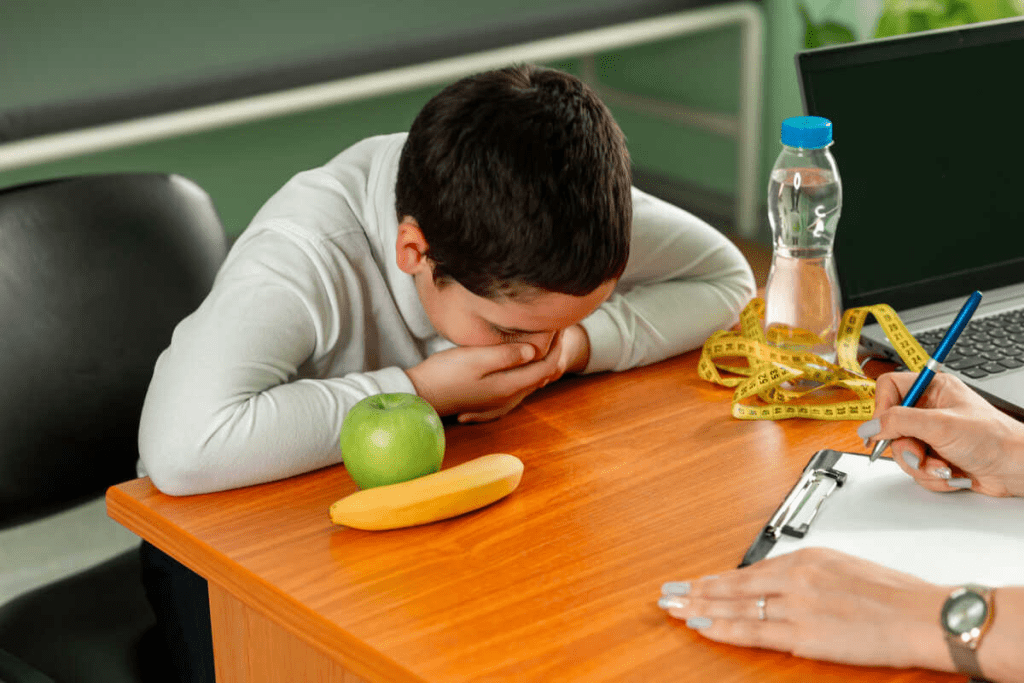Last Updated on November 14, 2025 by

Modern healthcare faces a big challenge: the connection between screen time and obesity in kids. Studies show that too much screen time raises the risk of obesity in children. Kids who watch screens for more than four hours a day are 43% more likely to be overweight or obese. This scary fact shows why families need to set screen-time rules. These rules help kids live healthier and lower the chance of obesity. At LivHospital, we’re tackling this serious health issue with top-notch services and responsible approaches to sl advertising. By understanding how technology leads to obesity in kids, we aim to make a better future for them.

America is seeing a high rate of childhood obesity. Screen time is a big part of this problem. The numbers show how our kids’ health is at risk.
Studies say kids who watch more than four hours of screens a day are 43% more likely to be overweight. This isn’t just a coincidence. It’s because they sit too much and see ads for unhealthy food.
Watching more than four hours of screens a day can lead to obesity in kids. It makes them less active. A study on PMC shows a clear link between screen time and obesity risk.
Also, too much screen time often means eating unhealthy snacks. These snacks are often high in calories and are advertised during kids’ shows. This mix of less exercise and more calories can cause weight gain.
Screen time among American kids is going up. They spend more time watching screens than ever before. This includes TV, video games, mobile devices, and computers.
It’s important to understand how these trends affect childhood obesity. By knowing the problem and its causes, we can start to find ways to reduce the risks of too much screen time.
Setting rules for screen time and encouraging healthier habits is key. This can help lower obesity rates in American kids. It creates a better environment for them to grow up in.

The link between screen time and obesity is complex. Sedentary behaviour, or sitting for long periods, is a big risk for obesity in kids. Cutting down on screen time is key to staying healthy.
Sitting too much leads to less physical activity and burning fewer calories. Kids who watch screens more do less physical stuff. This makes it hard for them to keep a healthy weight.
Being sedentary also makes it tough to stay fit. This makes it hard to do physical activities, starting a bad cycle. We need to get kids moving more to fight this.
Sitting for long can change how our body works, leading to weight gain. Studies show it can lower insulin sensitivity and raise blood pressure. These changes increase the risk of obesity and other health problems.
Also, sitting too much can make us want to eat more, often unhealthy foods. This makes gaining weight even more likely. Parents and caregivers should watch and limit screen time to help.
Knowing how sitting leads to weight gain helps us find ways to stop it. We can encourage more physical activity, limit screen time, and teach healthy eating habits.
Children spending more time on screens has led to a worrying trend: mindless snacking. This happens when they eat while watching digital content. It results in eating too many calories and making unhealthy food choices.
Children often eat while watching TV, playing games, or using apps. They might not notice when they’re full. This distracted eating can lead to eating more than they need.
Research shows kids who snack while on screens choose foods high in calories but low in nutrients. Ads they see during screen time also influence their choices, making unhealthy eating habits worse.
Common consequences of distracted eating include:
Children often grab snacks that are easy to eat while watching screens. These snacks are often high in calories, sugar, and unhealthy fats. Examples include:
To fight mindless snacking, parents can try a few things. Turning off screens during meals and snacks helps kids pay attention to their hunger and fullness. Also, giving them healthy snack options and limiting junk food can help them make better choices.
“By promoting healthy eating habits and being mindful of screen time, we can help children develop a healthier relationship with food and reduce the risk of obesity.”
Understanding the connection between screen time and snacking can help us promote healthier habits in kids. We can set limits on screen time, encourage physical activity, and support mindful eating.
Food ads have a big impact on kids’ eating habits, leading to more childhood obesity. Advertisers use special ways to grab kids’ attention, shaping what they like to eat.
Advertisers use cartoon characters, toys, and games to make unhealthy food look fun. This makes junk food seem cool and easy to remember for kids.
With digital tech, ads reach kids everywhere, like on social media, YouTube, and mobile apps. This makes it hard for parents to keep kids away from ads for bad food.
Studies show a link between ads and what kids eat. Kids who see more ads tend to eat more unhealthy foods, which can lead to obesity.
A study showed kids who watched more TV (and ads) ate more bad snacks. This shows we need rules to limit ads to kids to fight childhood obesity.
At 5 Harris Way, Georgetown, MA, doctors are fighting childhood obesity. They teach families about the effects and how to choose healthier foods.
By knowing how ads influence kids and finding ways to fight it, we can lower obesity rates in kids.
Screen time is a big worry for kids’ health, including weight. It’s linked to sleep problems. More kids are using screens, and research is looking into how it affects sleep and weight.
Screen time messes with sleep because of blue light exposure. Blue light from screens can stop melatonin production. Melatonin helps us sleep. Without enough, it’s hard to fall asleep, and sleep quality drops.
Blue light in the evening delays melatonin release. This makes it tough for kids to sleep. Poor sleep affects overall health, including weight, by messing with hunger and fullness hormones.
The link between sleep and obesity in kids is complex. Poor sleep quality is a big factor in childhood obesity. Without enough sleep, kids eat more because of hormonal changes.
Also, sleep issues can mess with glucose control. This makes weight management harder. Parents should limit screen time before bed to help.
Knowing how screens affect sleep and weight helps us fight childhood obesity. We need to teach kids about healthy sleep and limit screen time before bed.
There’s a strong link between digital media and emotional eating in kids. As we look into how screen time affects obesity, it’s clear that digital media impacts kids’ emotions and eating.
Being on digital media can cause stress and worry in kids. The endless info, the need to stay online, and bullying can make them feel anxious. This stress can make kids eat emotionally, as a way to deal with their feelings.
Studies show stressed and anxious kids eat emotionally more. This can cause weight gain and obesity. Parents need to know these risks and act to prevent them.
Social media affects kids’ body image and self-esteem. Seeing perfect images and feeling pressured to look a certain way can hurt their self-image. This can lead to emotional eating, as kids try to deal with their feelings through food.
“The constant bombardment of unrealistic beauty standards on social media can have a devastating impact on young people’s self-esteem and body image.”
To help kids manage their emotions and avoid emotional eating, parents can do several things:
By doing these things, we can help kids have better relationships with digital media and lower the chance of emotional eating. As we deal with the complex relationship between technology and health, we must focus on our kids’ well-being. We need to give them the tools to succeed in a digital world.
It’s key to know how screen time affects obesity in kids. We’ll look at how more screen time links to higher BMI percentiles. We’ll also find out the safe limits for different ages.
Research shows a clear link between screen time and obesity. More screen time means a higher risk of obesity. Kids who watch more than four hours a day are 43% more likely to be obese.
The American Academy of Pediatrics suggests 1-2 hours of quality screen time daily for kids 2-18. Following these rules can lower obesity risk. Kids under 2 should only watch video calls or educational shows with a parent.
Remember, these are just guidelines. The right amount of screen time varies for each child’s lifestyle. Parents should consider physical activity and diet when setting limits.
By understanding the effects of screen time and setting limits, we can fight obesity in kids.
Setting simple screen-time rules early is key to healthy habits in kids. Kids aged 3 to 5 spend about 2 hours daily on screens. Only 15% meet guidelines for less than 1 hour of screen time. You can learn more about screen time effects in this study.
At LivHospital, we focus on quality health services. We see how screen time can lead to obesity in America. Understanding these risks helps parents create a healthier space for their kids.
Limiting screen time and encouraging physical activity are important. This helps prevent obesity and health problems. We support a balanced approach to screen use for kids’ well-being.
Screen time can lead to obesity in kids. It makes them sit too much, snack without thinking, and see ads for unhealthy food.
Too much screen time can harm kids. It increases the chance of obesity, lowers physical activity, and changes metabolism. It also disrupts sleep and can make kids eat emotionally.
Parents can help by setting screen rules, encouraging exercise, and watching what food ads kids see. They should also teach healthy eating and how to manage feelings.
Screen time can mess up sleep. The blue light from screens stops melatonin production. This can lead to not enough sleep, weight gain, and obesity.
Food ads can shape what kids eat. They often push high-calorie, high-fat, and sugary foods. These ads use tricks to grab young viewers’ attention.
To cut down screen time and boost activity, parents can encourage outdoor play. They should play sports with their kids and limit screen time to four hours a day.
Technology can cause obesity by making kids sit too much, snack without thinking, and see ads for bad food. This can lead to weight gain and obesity.
The more screen time, the higher the risk of obesity. Longer screen time is linked to higher BMI and a higher risk.
Screen time limits change with age. The American Academy of Pediatrics says kids under five should not watch more than one hour of screens. Older kids also need limits.
Subscribe to our e-newsletter to stay informed about the latest innovations in the world of health and exclusive offers!